
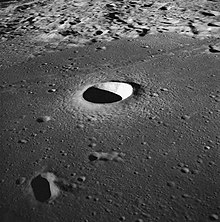
Lunar craters are impact craters on Earth's Moon. The Moon's surface has many craters, all of which were formed by impacts. The International Astronomical Union currently recognizes 9,137 craters, of which 1,675 have been dated. [1]


Lunar craters are impact craters on Earth's Moon. The Moon's surface has many craters, all of which were formed by impacts. The International Astronomical Union currently recognizes 9,137 craters, of which 1,675 have been dated. [1]
The word crater was adopted from the Greek word for "vessel" (Κρατήρ, a Greek vessel used to mix wine and water). Galileo built his first telescope in late 1609, and turned it to the Moon for the first time on November 30, 1609. He discovered that, contrary to general opinion at that time, the Moon was not a perfect sphere, but had both mountains and cup-like depressions. These were named craters by Johann Hieronymus Schröter (1791), extending its previous use with volcanoes.
Robert Hooke in Micrographia (1665) proposed two hypotheses for lunar crater formation: one, that the craters were caused by projectile bombardment from space, the other, that they were the products of subterranean lunar volcanism. [2]
Scientific opinion as to the origin of craters swung back and forth over the ensuing centuries. The competing theories were:
Grove Karl Gilbert suggested in 1893 that the Moon's craters were formed by large asteroid impacts. Ralph Baldwin in 1949 wrote that the Moon's craters were mostly of impact origin. Around 1960, Gene Shoemaker revived the idea. According to David H. Levy, Shoemaker "saw the craters on the Moon as logical impact sites that were formed not gradually, in eons, but explosively, in seconds." [3]

Evidence collected during the Apollo Project and from uncrewed spacecraft of the same period proved conclusively that meteoric impact, or impact by asteroids for larger craters, was the origin of almost all lunar craters, and by implication, most craters on other bodies as well.
The formation of new craters is studied in the lunar impact monitoring program at NASA. [4] The biggest recorded crater was caused by an impact recorded on March 17, 2013. [5] [6] Visible to the naked eye, the impact is believed to be from an approximately 40 kg (88 lb) meteoroid striking the surface at a speed of 90,000 km/h (56,000 mph; 16 mi/s).
In March 2018, the discovery of around 7,000 formerly unidentified lunar craters via convolutional neural network developed at the University of Toronto Scarborough, Canada was announced. [7] [8] A similar study in December 2020 identified around 109,000 new craters using a deep neural network. [1]
Because of the Moon's lack of water, atmosphere, and tectonic plates, there is little erosion, and craters are found that exceed two billion years in age. The age of large craters is determined by the number of smaller craters contained within it, older craters generally accumulating more small, contained craters.

The smallest craters found have been microscopic in size, found in rocks returned to Earth from the Moon. The largest crater called such is about 290 km (180 mi) across in diameter, located near the lunar south pole. However, it is believed that many of the lunar maria were formed by giant impacts, with the resulting depression filled by upwelling lava.
Craters typically will have some or all of the following features:
There are at least 1.3 million craters larger than 1 km (0.62 mi) in diameter; of these, 83,000 are greater than 5 km (3 mi) in diameter, and 6,972 are greater than 20 km (12 mi) in diameter. [9]
In 1978, Chuck Wood and Leif Andersson of the Lunar & Planetary Lab devised a system of categorization of lunar impact craters. [10] They used a sampling of craters that were relatively unmodified by subsequent impacts, then grouped the results into five broad categories. These successfully accounted for about 99% of all lunar impact craters.
The LPC Crater Types were as follows:
Beyond a couple of hundred kilometers diameter, the central peak of the TYC class disappear and they are classed as basins. Large craters, similar in size to maria, but without (or with a small amount of) dark lava filling, are sometimes called thalassoids. [upper-alpha 1] [12] [13]
Beginning in 2009 Nadine G. Barlow of Northern Arizona University, U.S. began to convert the Wood and Andersson lunar impact-crater database into digital format. [14] Barlow is also creating a new lunar impact crater database similar to Wood and Andersson's, except hers will include all impact craters greater than or equal to five kilometers in diameter and is based on the Clementine spacecraft's images of the lunar surface.
The Moon Zoo project within the Zooniverse program aimed to use citizen scientists to map the size and shape of as many craters as possible using data from the NASA Lunar Reconnaissance Orbiter. However, it has since been retired. [15]
Craters constitute 95% of all named lunar features. [16] Usually they are named after deceased scientists and other explorers. [17] This tradition comes from Giovanni Battista Riccioli, who started it in 1651. [18] [19] Since 1919, assignment of these names is regulated by the International Astronomical Union. [18]
Small craters of special interest (for example, visited by lunar missions) receive human first names (Robert, José, Louise etc.). One of the biggest lunar craters, Apollo, is named after Apollo missions. Many smaller craters inside and near it bear the names of deceased American astronauts, and many craters inside and near Mare Moscoviense bear the names of deceased Soviet cosmonauts. [16] [17] Besides this, in 1970 twelve craters were named after twelve living astronauts (6 Soviet and 6 American). [16]
The majority of named lunar craters are satellite craters: their names consist of the name of a nearby named crater and a capital letter (for example, Copernicus A, Copernicus B, Copernicus C and so on). [16]
Lunar crater chains are usually named after a nearby crater. Their Latin names contain the word Catena ("chain"). For example, Catena Davy is situated near the crater Davy. [16] [20]
The red marker on these images illustrates the location of the named crater feature on the near side of the Moon.
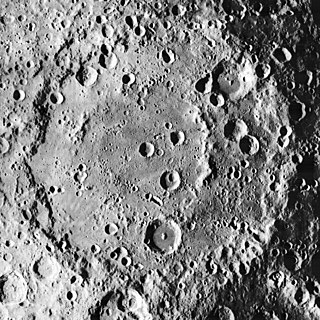
Korolev is a large lunar impact crater of the walled plain or basin type. It is a basin of Nectarian age.

Apollo, also called the Apollo basin, is an enormous impact crater located in the southern hemisphere on the far side of the Moon. This formation dwarfs the large crater Oppenheimer that is located next to the western rim. The crater Barringer lies across the northern wall. To the southeast is the crater Anders, and Kleymenov is just to the east of the rim.

Bilharz is a lunar impact crater that lies in the eastern part of the Mare Fecunditatis. It is the largest member of a close triple-crater formation with Atwood to the east and Naonobu to the northeast. To the southeast is the crater Langrenus.
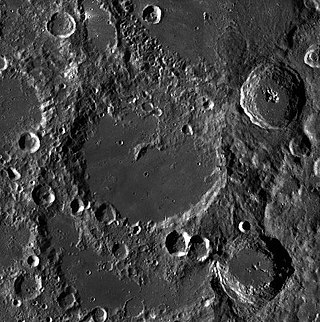
Von Kármán is a large lunar impact crater that is located in the southern hemisphere on the far side of the Moon. The crater is about 186 km (116 mi) in diameter and lies within an immense impact crater known as the South Pole–Aitken basin of roughly 2,500 km (1,600 mi) in diameter and 13 km (8.1 mi) deep. Von Kármán is the site of the first soft-landing on the lunar far side by the Chinese Chang'e 4 spacecraft on 3 January 2019.

Beals is a lunar impact crater that is located near the eastern limb of the Moon, and lies across the southwestern rim of the crater Riemann. From the Earth the crater is viewed nearly from on edge, and is best seen during favorable librations. To the west is the large walled plain Gauss.

Bečvář is a lunar impact crater that is located near the equator on the far side of the Moon. It lies to the northeast of the crater Necho, within that feature's ray system. To the north-northeast is the crater Gregory.

Einstein is a large lunar impact crater that lies along the western limb of the Moon, which makes it difficult to observe from the Earth. The visibility of this formation is subject to libration effects, but even under the best conditions not much detail can be observed except from lunar orbit. Nearby craters of note include Moseley just to the north, Dalton along the eastern rim, Vasco da Gama just to the southeast, and Bohr to the south-southeast. The formation Vallis Bohr is visible to the south.
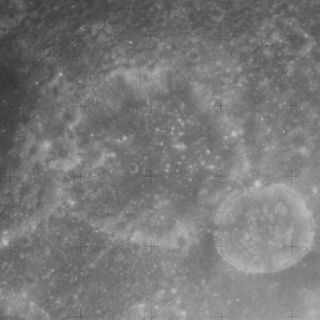
Jenkins is a lunar impact crater that lies along the equator of the Moon, near the eastern limb. It is attached to the eastern rim of the slightly larger crater Schubert X, intruding somewhat into the interior. The crater Nobili is likewise attached to the western rim of Schubert X and intrudes slightly into the interior on that side. The three craters form a linear chain along the equator.

Dellinger is a lunar impact crater that is located on the Moon's far side. It is attached to the southern rim of the crater Pannekoek. To the southeast lies the crater Marconi, and to the southwest is Chauvenet.

Dobrovolʹskiy is a small lunar impact crater on the Moon's far side. The northwest part of its rim is intruded upon by the somewhat larger crater Shirakatsi, and the outer rampart of that feature covers most of the interior floor of Dobrovolʹskiy. Very little of the original floor now survives, with a small section near the southern inner wall. The remainder of the crater rim is somewhat circular and only mildly worn.

Fleming is a large lunar impact crater that is located on the Moon's far side, and cannot be seen from the Earth. It lies about a crater diameter to the east-northeast of Hertz, and to the northwest of Lobachevskiy.
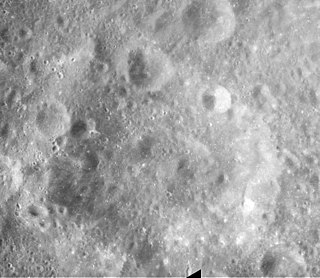
Gregory is a lunar impact crater on the far side of the Moon. It is located to the southeast of the crater Ibn Firnas, and north-northeast of Bečvář. About one crater diameter to the north is the smaller Morozov.

Mandelʹshtam is the remains of a large crater on the Moon's far side named after Leonid Mandelstam. Nearly attached to the northeast outer rim is the crater Papaleksi. To the south lies the crater Vening Meinesz.

Szilard is a damaged lunar impact crater that lies to the east-northeast of the crater Richardson. It is named after Leó Szilárd, the scientist who theorised nuclear chain reactions and famously worked on the atomic bomb during World War II. About a half-crater-diameter to the northwest is the large walled plain Harkhebi. Between Harkhebi and Szilard is the small Giordano Bruno. The ray system from this impact forms streaks across the rim and interior of Szilard.

Vening Meinesz is a lunar impact crater on the far side of the Moon. The northern inner wall of this crater lies along the lunar equator. To the north of this formation is the larger crater Mandel'shtam, and slightly farther to the south is the larger Keeler. Dewar is located less than one crater diameter to the southeast of Vening Meinesz.

Möbius is a lunar impact crater that is located on the Moon's far side, beyond the eastern limb and northeast of the Mare Marginis. It lies less than one crater diameter to the northwest of the larger, 90-km-diameter Hertz, and just to the southeast of Popov. To the north of Mobius is the crater chain designated Catena Dziewulski, which takes its name from the crater Dziewulski to the north-northwest.
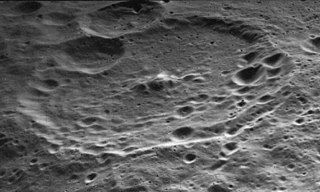
Schuster is a lunar impact crater that lies along the eastern rim of the much larger walled plain Mendeleev, on the far side of the Moon. To the east of Schuster is the crater Henderson, and to the southeast lies the large Chaplygin.
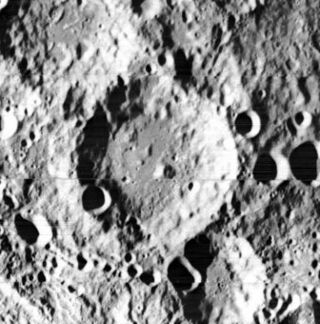
Stratton is a lunar impact crater on the Moon's far side. It is located to the north of the large craters Keeler and Heaviside, and less than one crater diameter to the south of Dewar.
{{cite thesis}}: CS1 maint: bot: original URL status unknown (link)